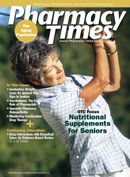Publication
Article
Pharmacy Times
Coagulation Counseling
Author(s):
Dr. Garrett is manager, Outpatient Clinical Pharmacy Programs, at Mission Hospitals in Asheville, North Carolina.
PPIs with Thienopyridines Do Not Interfere with Clinical Outcomes
A lot of discussion has arisen about the interaction between proton pump inhibitors (PPIs) and thienopyridines. Data regarding the effects on efficacy have been conflicting, especially with regard to clopidogrel and PPIs.
A group of international researchers assessed the association between PPI use, measures of platelet function in the lab, and clinical outcomes for patients treated with clopidogrel or prasugrel. In the Prasugrel in Comparison to Clopidogrel for Inhibition of Platelet Activation and Aggregation—Thrombolysis in Myocardial Infarction (PRINCIPLETIMI) 44 trial, the primary outcome was inhibition of platelet aggregation at 6 hours assessed by light-transmission aggregometry. In the Trial to Assess Improvement in Therapeutic Outcomes by Optimizing Platelet Inhibition with Prasugrel–Thrombolysis in Myocardial Infarction (TRITON-TIMI) 38, the primary end point was the composite of cardiovascular death, myocardial infarction, or stroke in the enrolled patients.
In the PRINCIPLE-TIMI 44 trial, 201 patients undergoing percutaneous coronary intervention were randomly assigned to prasugrel (n = 102) or high-dose clopidogrel (n = 99). Mean inhibition of platelet aggregation was significantly lower for patients on a PPI at 6 hours after a 600-mg clopidogrel loading dose. This effect was less with a 60-mg loading dose of prasugrel.
In the TRITON-TIMI 38 trial, 13,608 patients with an acute coronary syndrome were randomly assigned to prasugrel or clopidogrel. In this study, 33% of patients were on a PPI at randomization. No association existed between PPI use and risk of the primary end point for patients treated with clopidogrel or prasugrel.
Net Benefit of Warfarin for Atrial Fibrillation
A recently published assessment of a cohort of 13,559 patients sought to quantify the net clinical benefit of warfarin therapy for treatment of nonvalvular atrial fibrillation. Data was collected on warfarin use, patient characteristics, CHADS2 score and outcome events. Net clinical benefit was defined as the annual rate of ischemic strokes and systemic emboli prevented by warfarin minus intracranial hemorrhages attributable to warfarin, multiplied by an impact weight. The base-case impact weight was 1.5, reflecting the greater clinical impact of intracranial hemorrhage versus thromboembolism.
They found that the adjusted net clinical benefit of warfarin for the cohort overall was 0.68% per year. Net clinical benefit was greatest for patients with a history of ischemic stroke (2.48% per year) and for those 85 years of age or older (2.34% per year). The net clinical benefit of warfarin increased from nearly zero in CHADS2 stroke risk categories 0 and 1 to 2.22% per year in CHADS2 categories 4 to 6.
The bottom line of the study: warfarin was of greatest benefit to older patients, especially those older than 85 years of age. This age group is the one in which physicians are most reluctant to use the drug, however, due to the perceived risk of adverse effects. Other patient groups who benefited significantly included those with a prior history of stroke or high stroke risk.
New Resource Available for VTE Literature and Treatment Guidelines
Venous thromboembolism (VTE) affects millions of patients each year. Appropriate management not only leads to quicker resolution of the initial event, but can reduce the frequency of long-term complications such as pulmonary hypertension and postthrombotic syndrome.
Leading experts in the field of anticoagulation and management of VTE have compiled an extensive list of key articles and guidelines for the treatment of VTE. This bibliography is intended to be a resource for pharmacists, physicians, nurses, residents, and students responsible for the care of patients with VTE.
With the increased regulatory focus on appropriate management of anticoagulation therapy, it is important to have access to key reference material to make sound evidence-based treatment decisions. This document provides a central location for this information, and can be located at www. pharmacotherapy.org. â–







